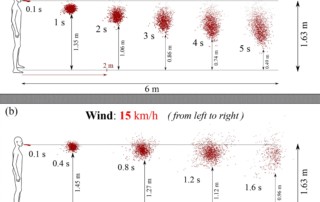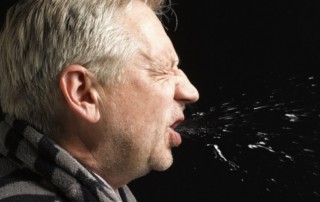COVID-19
UNIC Coronavirus Health and Research Portal
On Coughing and Airborne Droplet Transmission to Humans
Talib Dbouk and Dimitris Drikakis
University of Nicosia, Nicosia, Cyprus
The recent COVID-19 pandemic prompted the need for deeper understanding of the transport of fluids and droplets emanating from our respiratory tracts when we cough, sneeze, speak or breathe. The droplets transport will influence the spread of coronavirus and determine the implementation of guidelines about social distancing, mask wearing, crowded gatherings, as well as everyday practices of social behaviour in private, public and business environments.
The results of our research showed that in open spaces, airborne droplets carriers can travel significantly further than the 2 meters recommended distance due to the wind speed. The issues arising from the past and recent pandemic require a holistic approach to elucidate the open scientific questions and address the practical challenges. Such an approach would require closer interaction between bio-medicine, engineering fluid physics, and social sciences.
Figure 1
Saliva droplet cloud kinematics show the diameter of the droplets resulting from a human cough. Larger droplets settle more rapidly than smaller ones due to gravitational forces. The wind speed is approximately 0 km/h. The total mass of ejected saliva is 7.7 mg, with 1008 total number of droplets. The environment is at ambient temperature, pressure, and relative humidity of 20 oC, 1 atm, and 50%, respectively, with the ground temperature at 15 oC. The droplets in the figure have been scaled up for visualisation purposes.
Figure 2
A human cough: saliva droplet’s disease-carrier particles emanating from coughing do not travel more than 2 m in space at approximately zero wind speed. The environment was considered to be at ambient temperature, pressure, and relative humidity of 20 oC, 1 atm and 50% with the ground temperature at 15 oC.
Figure 3
Saliva droplets can travel large distances, depending on environmental conditions such as wind speed, temperature, pressure and humidity. Wind shown blowing left to right at speeds of 4 km/h (top) and 15 km/h (bottom) can transport saliva droplets up to 6 meters. The droplets in the figure have been scaled up for visualisation purposes.
What Does This Mean?
- In open spaces, airborne droplet carriers can travel significantly further than the 2m recommended distance depending on the wind speed and the environmental conditions. The above is an important finding and Citizens and policy-makers should be aware of it.
- If a person is in the path of the virus cloud, the risk of infection will, most likely, depend on the dosage and time of exposure. Therefore, it is crucial to better understand which scenarios may allow the transmission at longer distances. The present study contributes to advancing the above understanding.
- The dosage and time needed for an infection is still under study and may vary from one person to another. Further research and closer interaction between bio-medicine and engineering fluid physics are necessary to understand the conditions under which patients are being infected.
Non-Technical Summary
The recent COVID-19 pandemic prompted the need for deeper understanding of the transport of fluids and droplets emanating from our respiratory tracts when we cough, sneeze, speak or breathe. The droplets transport will influence the spread of coronavirus and determine the implementation of guidelines about social distancing, mask wearing, crowded gatherings, as well as everyday practices of social behaviour in private, public and business environments.
When sneezing or coughing, larger droplets are formed by saliva, and smaller droplets by mucous coating of the lungs and vocal cords. The smaller droplets are often invisible to the naked eye. Past research has shown that most respiratory droplets do not travel independently on their trajectories. Instead, droplets in a continuum of sizes are trapped and carried forward within a moist, warm, turbulent cloud of air. Although the mechanisms of virus transmission are still under debate, it is widely accepted that aerosol or respiratory droplet transmission is the critical factor for the rapid spread and continued circulation of viruses in humans.
We think that it is likely the dosage and time of exposure which determine whether or not infection will finally occur. Therefore, it is crucial to decide on the scenarios that will allow the transmission to longer distances. Our study aimed at advancing the understanding of the transfer of airborne particle carriers to humans through advanced coupling between droplets and fluid flow modeling and simulation.
The initial modeling configuration of the problem takes into account several parameters that can influence the simulation, including the wind speed in an open environment.
An accurate prediction of the transfer of airborne particle carriers to humans from a cough is governed by the following modeling considerations that must be taken into account:
- The saliva droplets initial size distribution at the onset of the coughing event.
- The human mouth-print of the cough.
- The period of the cough and its intensity (or initial saliva droplets speed).
- The numerical modeling approach to capture the complex varying space and time scales, e.g. both heat and mass transfer considerations, modeling of mass and phase changes due to droplets evaporation, coalescence, break up and turbulent dispersion in interaction with the bulk flow field.
The computational domain in the simulation is a grid in front of the coughing person . The analysis involved running partial differential equations on 1008 saliva droplets and solving approximately 3.7 million equations in total.
Our findings showed that, when a person coughs, the wind speed in an open space environment significantly influences the distance that airborne disease-carrier droplets travel.
- Without surrounding wind speed, the droplets will fall to the ground in a short distance from the person exhaling or coughing. The present analysis shows that the range may not exceed one meter (See Figure 2). A tiny number of particles may travel slightly further longer. Still, their trajectory beyond one meter will already be at a height significantly below half a meter dropping towards the ground. Thus, these droplets may not constitute a risk regarding facial contact of adults at this distance.
- At wind speeds from 4 to 15 km/h, we found that saliva droplets can travel to distances up to 6 meters with decreasing concentrations and liquid droplets size in the wind direction (see Figure 2). Our findings imply that depending on the environmental conditions, the 2 meters social distance may not suffice. Further research is required to quantify the influence of other parameters such as the environment relative humidity and temperature amongst others.
- The droplets cloud will affect both adults and children of different heights. Shorter adults and children could be at higher risk if they are located within the trajectory of falling droplets.
- At a lower wind speed, the droplet total mass reduction occurs more slowly compared to a higher speed, which may prolong the exposure of a human to the droplets if the subject is located within the droplets envelope.
Overall, the results showed that in open spaces, airborne droplets carriers can travel significantly further than the 2 meters recommended distance due to the wind speed. The issues arising from the past and recent pandemic require a holistic approach to elucidate the open scientific questions and address the practical challenges. Such an approach would require closer interaction between bio-medicine, engineering fluid physics, and social sciences.
Figure 1
Saliva droplet cloud kinematics show the diameter of the droplets resulting from a human cough. Larger droplets settle more rapidly than smaller ones due to gravitational forces. The wind speed is approximately 0 km/h. The total mass of ejected saliva is 7.7 mg, with 1008 total number of droplets. The environment is at ambient temperature, pressure, and relative humidity of 20 oC, 1 atm, and 50%, respectively, with the ground temperature at 15 oC. The droplets in the figure have been scaled up for visualisation purposes.
Figure 2
A human cough: saliva droplet’s disease-carrier particles emanating from coughing do not travel more than 2 m in space at approximately zero wind speed. The environment was considered to be at ambient temperature, pressure, and relative humidity of 20 oC, 1 atm and 50% with the ground temperature at 15 oC.
Figure 3
Saliva droplets can travel large distances, depending on environmental conditions such as wind speed, temperature, pressure and humidity. Wind shown blowing left to right at speeds of 4 km/h (top) and 15 km/h (bottom) can transport saliva droplets up to 6 meters. The droplets in the figure have been scaled up for visualisation purposes.
The University of Nicosia (UNIC)
About the University of Nicosia
The University of Nicosia (UNIC) is the largest university in Cyprus, and the largest university in southern Europe that teaches primarily in English, welcoming 12,000+ students from over 70 countries worldwide. The University of Nicosia is a comprehensive university with 6 schools, 20 departments and over 100 degree programs offered on-campus and online.
The University of Nicosia is best known in the fields of medicine, law, blockchain, accounting, education, forecasting and international relations and for a series of partnerships with other leading European universities. UNIC was most recently ranked #106 in its region by QS and #300 to #400 globally in the Times Higher Education Impact rankings.
To learn more about the University of Nicosia, please see: https://www.unic.ac.cy/
UNIC’s COVID-19 Response
University of Nicosia faculty across a variety of academic disciplines are actively engaged in research and analysis and serving in scientific / public policy roles supporting the global COVID-19 response.
For more information about the University of Nicosia’s work relating to COVID-19 including potential collaboration, please see: https://www.unic.ac.cy/coronavirus/
Contact Information
For more information about this study, please contact Prof Dimitris Drikakis at [email protected].
For more information on our COVID-19 related research in general, please contact UNIC at [email protected].
Press Coverage
Articles and press mentions in global media about the research.
Coronavirus, 1 metro di distanza non basta se si alza il vento
Coronavirus, 1 metro di distanza non basta se si alza il vento Dettagliato esame delle distanze di sicurezza con simulazione di una persona che tossisce: con lieve flusso d’aria in 5 secondi le goccioline raggiungono 6 metri Uno studio appena pubblicato su Physics of Fluids (una rivista scientifica che tratta della fluidodinamica, fondata dall’American Institute of Physics e realizzata da AIP Publishing) analizza nel dettaglio il comportamento delle goccioline emesse da un soggetto che tossisce in assenza di vento, con [...]
Corona research round-up: Immunity in monkeys, saliva and breeze; more
Corona research round-up: Immunity in monkeys, saliva and breeze; more Here's a review of the latest scientific studies on the SARS-CoV-2 coronavirus, as well as efforts to find treatments and vaccines. Monkeys who survive coronavirus infection immune to reinfection Two studies in monkeys offer some of the first scientific evidence that surviving Covid-19 may result in immunity from reinfection, as well as a positive sign that vaccines under development may succeed. In one of the new studies, researchers infected nine [...]
Husten: Speichel fliegt mit dem Wind
Hustet man im Freien geradeaus und nicht in die Armbeuge, wird die freigesetzte Speichelwolke schon bei einer Brise von 6 Stundenkilometern in 5 Sekunden 1,80 Meter weit getragen. Das zeigt eine Studie im Fachblatt „Physics of Fluids“. Bei der Verbreitung von Viren könne das von Bedeutung sein, warnen die Forscher. Ihren Simulationen zufolge haben Kinder und kleinere Erwachsene womöglich ein höheres Risiko, infektiöse Tropfen abzubekommen, weil die Wolke sinkt. Read more here: Husten: Speichel fliegt mit dem [...]
Πανεπιστήμιο Λευκωσίας: Σταγονίδια σιέλου από ανθρώπινο βήχα μπορούν να μεταφερθούν αρκετά πέρα των δύο μέτρων
Πανεπιστήμιο Λευκωσίας: Σταγονίδια σιέλου από ανθρώπινο βήχα μπορούν να μεταφερθούν αρκετά πέρα των δύο μέτρων Σύμφωνα με άρθρο ερευνητών του Πανεπιστημίου Λευκωσίας στο επιστημονικό περιοδικό Physics of Fluids, οι τρέχουσες οδηγίες κοινωνικής απόστασης των 2 μέτρων μπορεί να είναι ανεπαρκείς, διότι ένας ήπιος βήχας σε συνδυασμό με χαμηλές ταχύτητες ανέμου 4-15 km/h είναι δυνατό να μεταφέρει σταγονίδια σιέλου σε απόσταση 6 μέτρων... Διαβάστε ολόκληρο το άρθρο εδώ.
Two-metre distance may not be enough: Study
Two-metre distance may not be enough: Study Droplets of saliva can travel as far as six metres even in low wind speeds of 4kmph, a new study has found, indicating that current social distancing guidelines of two metres may be insufficient to stop a Covid-19 patient from transmitting the disease... Read the full article here.
Tired of being home most of the time, Americans in reopened states weigh the risks of going out
Tired of being home most of the time, Americans in reopened states weigh the risks of going out At Archie Moore's Bar and Restaurant in Milford, Connecticut, it was a beautiful Wednesday, and the patio was a full as it could be. But amid a deadly pandemic, full doesn't mean packed. Tables at the restaurant were 6 feet apart. There were single-use paper menus. Arrows told patrons which way to go in. Everyone needed a mask -- and if you didn't [...]
Tükürük damlacıkları, 5 saniyede, hafif bir rüzgarla 5 metreden uzağa taşınabilir
Tükürük damlacıkları, 5 saniyede, hafif bir rüzgarla 5 metreden uzağa taşınabilir Profesör Dimitris Drikakis, damlacıkların güzergahı yakınındalarsa çocuklar ve kısa boylu yetişkinlerin daha yüksek risk altında olabileceklerini söyledi Amerikan Fizik Enstitüsü'nde görevli bilim insanlarınca yapılan yeni bir araştırma, Coronavirus'un açık havada bulaşmasını engellemek için insanlar arasında 2 metre mesafenin yeterli olmayabileceğini gösterdi. Sonuçları Physics of Fluids dergisinde yayımlanan araştırma çerçevesinde Amerikan Fizik Enstitüsü'nde görevli bilim insanları bilgisayar simülasyonlarından faydalandı. Öksürmenin tükürük damlacıklarının havada nasıl hareket etmesine yol açtığı, saçılma şekilleri, tükürük [...]
Νέα έρευνα: Ακόμα κι ένα ελαφρύ αεράκι μεταφέρει τον ιό σε απόσταση 5,5 μέτρων
Νέα έρευνα: Ακόμα κι ένα ελαφρύ αεράκι μεταφέρει τον ιό σε απόσταση 5,5 μέτρων Αλλάζει όσα γνωρίζαμε μέχρι σήμερα για τον τρόπο μετάδοσης του Covid-19 μέσω του αέρα μια νέα έρευνα, η οποία φέρει ελληνική υπογραφή και δημοσιεύτηκε στο περιοδικό του Αμερικανικού Ινστιτούτου Φυσικής. Σύμφωνα με αυτήν, ακόμη και ένα ελαφρύ αεράκι με ταχύτητα τεσσάρων χιλιομέτρων την ώρα μπορεί να μεταφέρει τα σταγονίδια του σάλιου, ύστερα από βήχα, σε απόσταση έως 5,5 μέτρων! Αυτές είναι οι εκτιμήσεις του καθηγητή Δημήτρη [...]
When you cough, how far can it go?
When you cough, how far can it go? Airborne transmission of viruses is not well understood, but a good baseline for study is a deeper understanding of how particles travel through the air when people cough. Talib Dbouk and Dimitris Drikakis from the University of Nicosia, Cyprus, did just such an experiment and found that even in a slight breeze of 4km/hr, saliva droplets travel around six metres in five seconds. At 15km/hr, it takes as little as 1.6 seconds... [...]
Зараженные капельки слюны могут пролетать до пяти метров. | Журнал Популярная Механика
Зараженные капельки слюны могут пролетать до пяти метров Дистанция в два метра друг от друга может быть недостаточной для безопасного пребывания среди людей во время пандемии. Последнее исследование показало, что капельки слюны могут перемещаться более чем на пять метров за пять секунд при ветре около 4 км/ч. Ученые изучили компьютерное моделирование того, как кашель заставляет капельки слюны перемещаться по воздуху, принимая во внимание способ их рассеивания и взаимодействие молекул слюны и воздуха. Их моделирование также учитывало влияние влажности и температуры окружающего воздуха. Read the full article here: Зараженные капельки слюны могут пролетать до пяти метров. [...]













